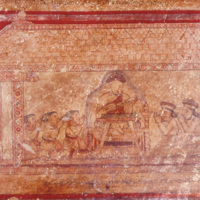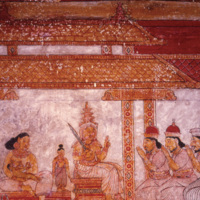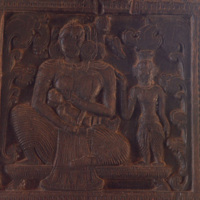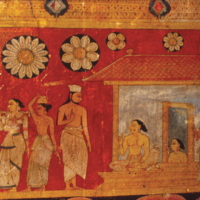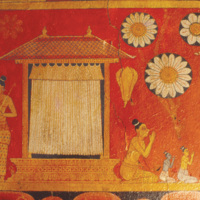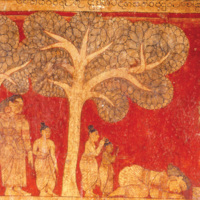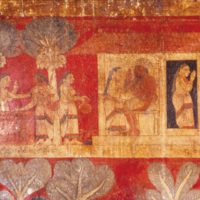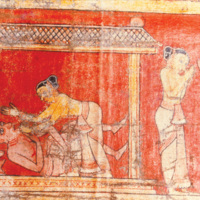Main Menu
AORC Libraries
Browse Archive Items (166 total)
Men and women learning at the feet of a Guru (teacher)
Description: It is however heartening to see that the Degaldoruva painter did not confine himself to illustration of women in purely domestic roles. This scene from the Sattubhatta Jataka (one of the former birth stories of the Buddha) shows and equal number of men and women listening to a learned man reading from an ola book.
Contributor: Co-Author: Seneviratna, Harsha
Collection: Women in Sri Lankan Sculpture and Painting
Tags: AISLS, ICES, PDWESLSP, The female in narrative art
Women in domestic service
Description: A kitchen scene with a female in action on the Arattana Vihare, petikade or painted scroll at Hanguranketa, Sri Lanka, illustrates the role of women preparing and serving food. In elite households. These functions were sometimes performed by female servants as in this instance.
Contributor: Co-Author: Seneviratna, Harsha
Collection: Women in Sri Lankan Sculpture and Painting
Tags: AISLS, ICES, PDWESLSP, The female in narrative art
A sharp definition of roles, King Vessantara and his queen
Description: Painted on the walls of the Degaldoruva temple is this scene from the Vessantara Jataka (one of the former birth stories of the Buddha). Seated next to each other, while Vessantara talks to state officials, the queen suckles her infant daughter, sharply defining her domestic role, away from matters of state.
Contributor: Co-Author: Seneviratna, Harsha
Collection: Women in Sri Lankan Sculpture and Painting
Tags: AISLS, ICES, PDWESLSP, The female in narrative art
A woman suckling her infant
Description: A popular concept of the female is in her role as mother. This is most often represented by a woman suckling her infant as seen in this 17th century A.D. wood carving at the Ambakke devalaya. The relief panel is carved on a pillar at the entrance pavilion.
Contributor: Co-Author: Seneviratna, Harsha
Collection: Women in Sri Lankan Sculpture and Painting
Tags: AISLS, ICES, PDWESLSP, The female in narrative art
Contrasting styles of women's attires
Description: This scene from the wall paintings of the Madavala Vihare illustrates an episode in the Uraga Jataka (one of the former birth stories of the Buddha). It is interesting to note that the ladies of the household, a Brahmin family according to the story, do not cover the upper part of their bodies when they are at home, but are fully clothed when they go out. In contrast, the maid does not cover the upper part of her body on either occasion.
Contributor: Co-Author: Seneviratna, Harsha
Collection: Women in Sri Lankan Sculpture and Painting
Tags: AISLS, ICES, PDWESLSP, The female in narrative art
Queen Madri-devi worshipping her husband (Vessantarā)
Description: This scene painted at the Madavala Vihare, shows the queen worshipping Vessantara (Vessantara Jataka, one of the former birth stories of the Buddha), holding her head straight.
Contributor: Co-Author: Seneviratna, Harsha
Collection: Women in Sri Lankan Sculpture and Painting
Tags: AISLS, ICES, PDWESLSP, The female in narrative art
Queen Madri-devi worshipping her husband (Vessantarā)
Description: This painter at Degaldoruva, illustrating another episode in the Vessantara Jataka (one of the former birth stories of the Buddha), shows Madri-devi worshipping at the feet of her husband when she sees him in the garb of an ascetic.
Contributor: Co-Author: Seneviratna, Harsha
Collection: Women in Sri Lankan Sculpture and Painting
Tags: AISLS, ICES, PDWESLSP, The female in narrative art
A painting on a temple wall, of a woman asserting herself over her aged husband
Description: This scene at the Degaldoruva Vihare in the Kandy district, Sri Lanka, is somewhat restrained, but is presented together with a group of women round a well, whose taunts provoke the young woman Amittatapa (Vessantara Jataka, one of the former birth stories of the Buddha) to assert herself. Although these paintings are only a visual expression of earlier literary woks, the choice of episodes and the manner in which they are presented may reveal 18th century attitudes.
Contributor: Co-Author: Seneviratna, Harsha
Collection: Women in Sri Lankan Sculpture and Painting
Tags: AISLS, ICES, PDWESLSP, The female in narrative art
A woman asserting her self over her aged husband
Description: Here is an occasion in which the female asserts herself over her aged husband in the Vessantara Jataka (one of the former birth stories of the Buddha). It is painted with great animation in this 18th century A.D., scroll painting found at the Arattana Vihare, Hanguranketa, Sri Lanka.
Contributor: Co-Author: Seneviratna, Harsha
Collection: Women in Sri Lankan Sculpture and Painting
Tags: AISLS, ICES, PDWESLSP, The female in narrative art
Women dancers as temptresses
Description: The temptations with which the Bodhisattva grappled are personified as the daughters of Mara, the evil one. In common with practically all the Kandyan temple paintings, the female as temptress, at the Dambulla Rock Temple, Sri Lanka, as shown here, is in dance pose. However, none of the daughters of Mara shown in the paintings of the Kandyan period can be described as sensuous creatures. For the 18th century Kandyan painter, the female as seductress perhaps lacked conviction.
Contributor: Co-Author: Seneviratna, Harsha
Collection: Women in Sri Lankan Sculpture and Painting
Tags: AISLS, ICES, PDWESLSP, The female in narrative art



